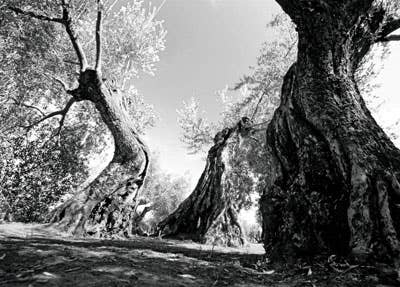
Tree of Life
The olive tree is as deeply embedded in the history and mythology of olive-growing lands as it is in the Mediterranean landscape itself.
You plant grapevines for your children, my Tuscan neighbors say, and olive trees for your grandchildren. It can take as long as 40 years for Olea europaea, the olive tree, to grow to full maturity (though many begin bearing fruit after just five to seven years). Once planted, however, barring frost, fire, or flood, the tree can live for centuries, its taproot stretching deep—up to 20 feet—into the soil, seeking moisture. All over the Mediterranean—from Andalusia in Spain (where this photo was taken) to Puglia in Italy to Kalamata in Greece—you'll find ancient, gnarled trees still faithfully producing delicious fruit every fall.
The olive tree is as deeply embedded in the history and mythology of olive-growing lands as it is in the landscape itself. Olive trees may have originated in the Middle East, possibly in what is now Syria, but as they moved west with human settlement, into Lebanon, Turkey, Greece, Italy, southern Spain, and North Africa, their bounty made a deep impression on the people who lived in those places. The trees' fruit and the oil it produced were considered nothing short of miraculous. The oil was used as a food and also as a balm for the ill, an unguent for cleansing the skin, and fuel in lamps.
The three great Abrahamic faiths—all rooted in lands where olive trees grow—pay heed to the trees' gifts: it's no accident that olives provide the chrism, or consecrated oil, used in Greek and Latin churches for baptisms and ordinations. Or that the miracle celebrated at Hanukkah commemorates a spontaneously replenished supply of olive oil in the lamps that lit the Temple of Jerusalem. Here is the tree again, in the Koran: "A sacred tree. . . [whose] oil almost gives light of itself though no fire touches it.
Today, the olive tree has spread far afield—to North and South America, Australia and New Zealand, India and China. But wherever its split trunk rises and its knobby, twisted branches and silvery leaves cast shade, the olive tree remains a beloved and quintessential symbol of the Mediterranean, its historic home.
Keep Reading
Continue to Next Story










